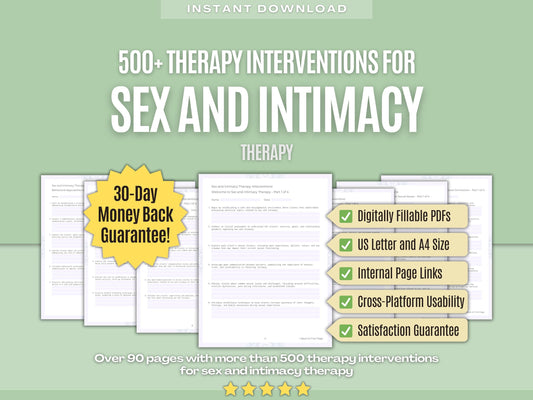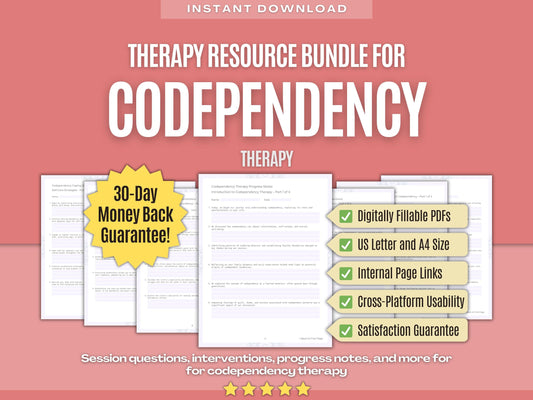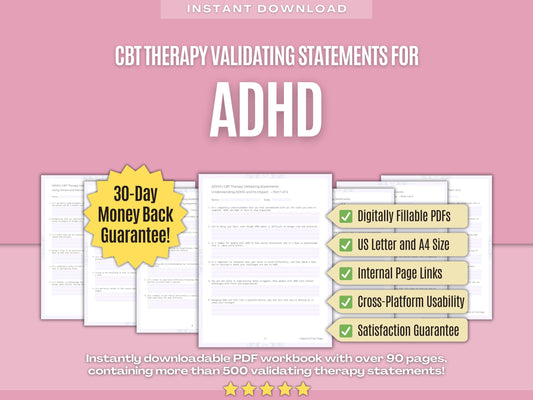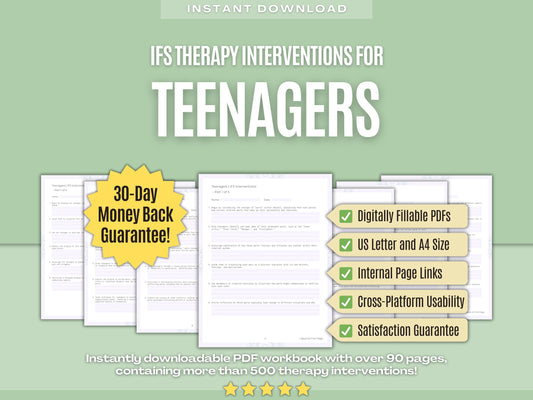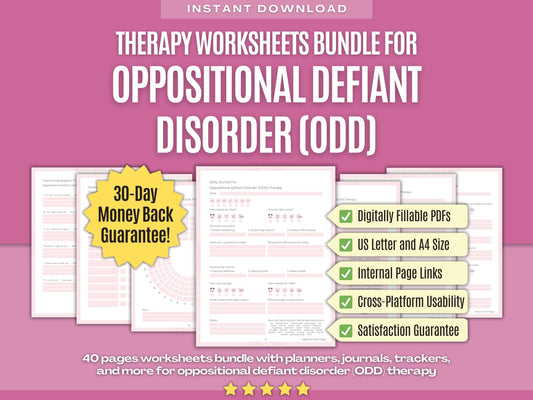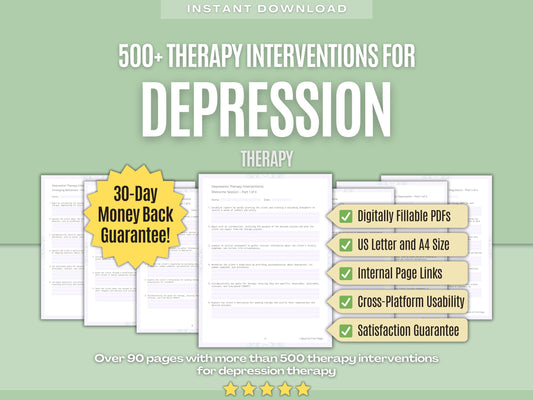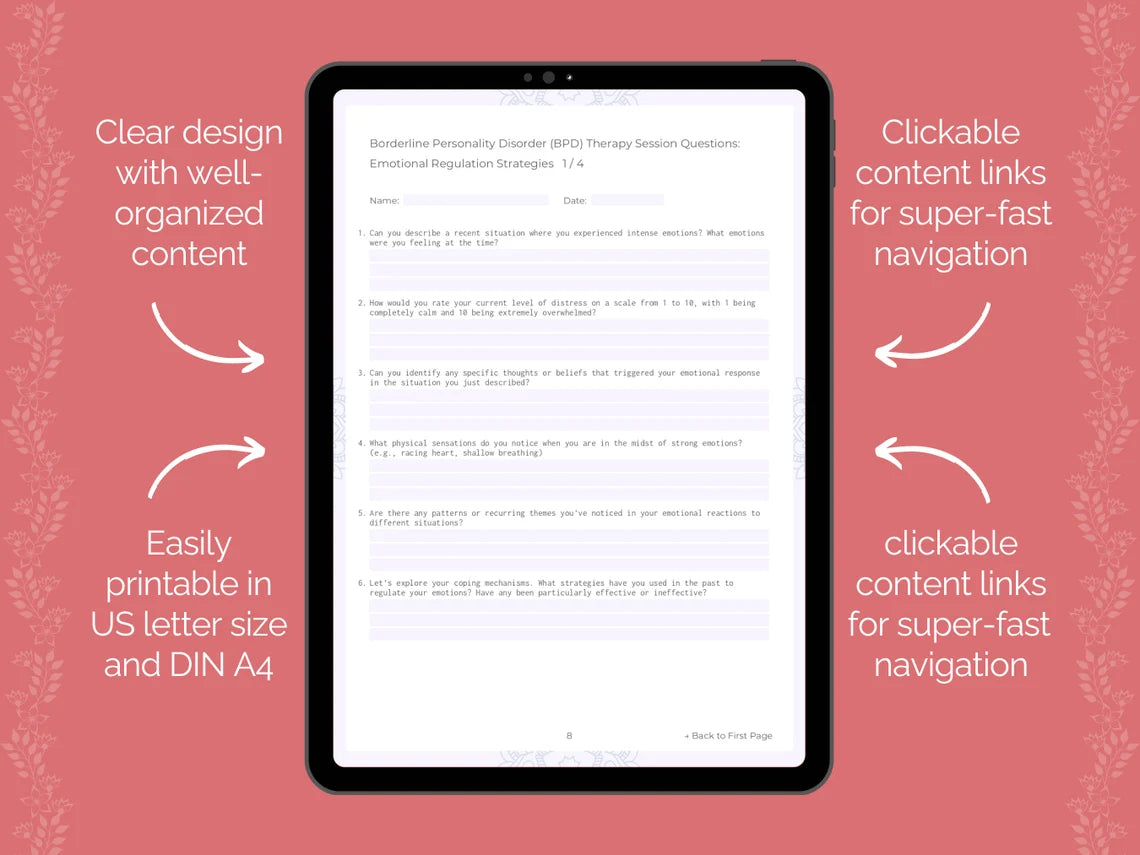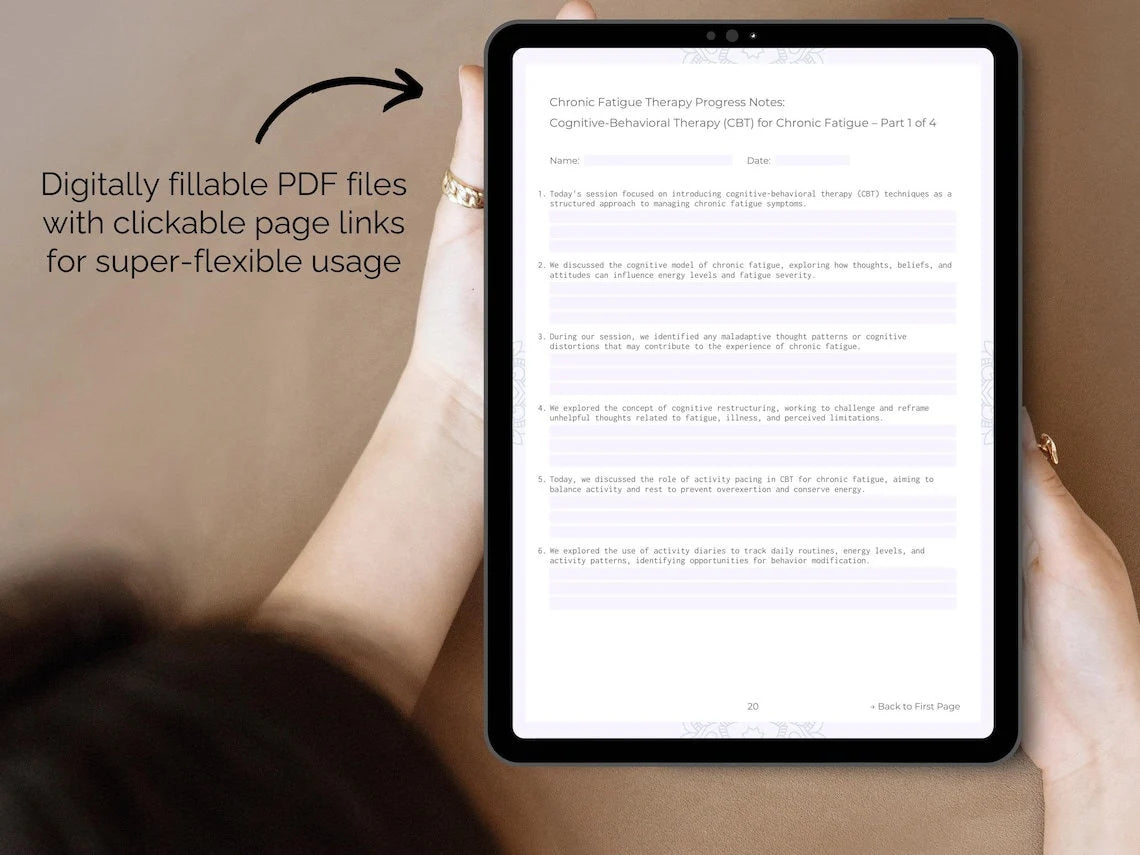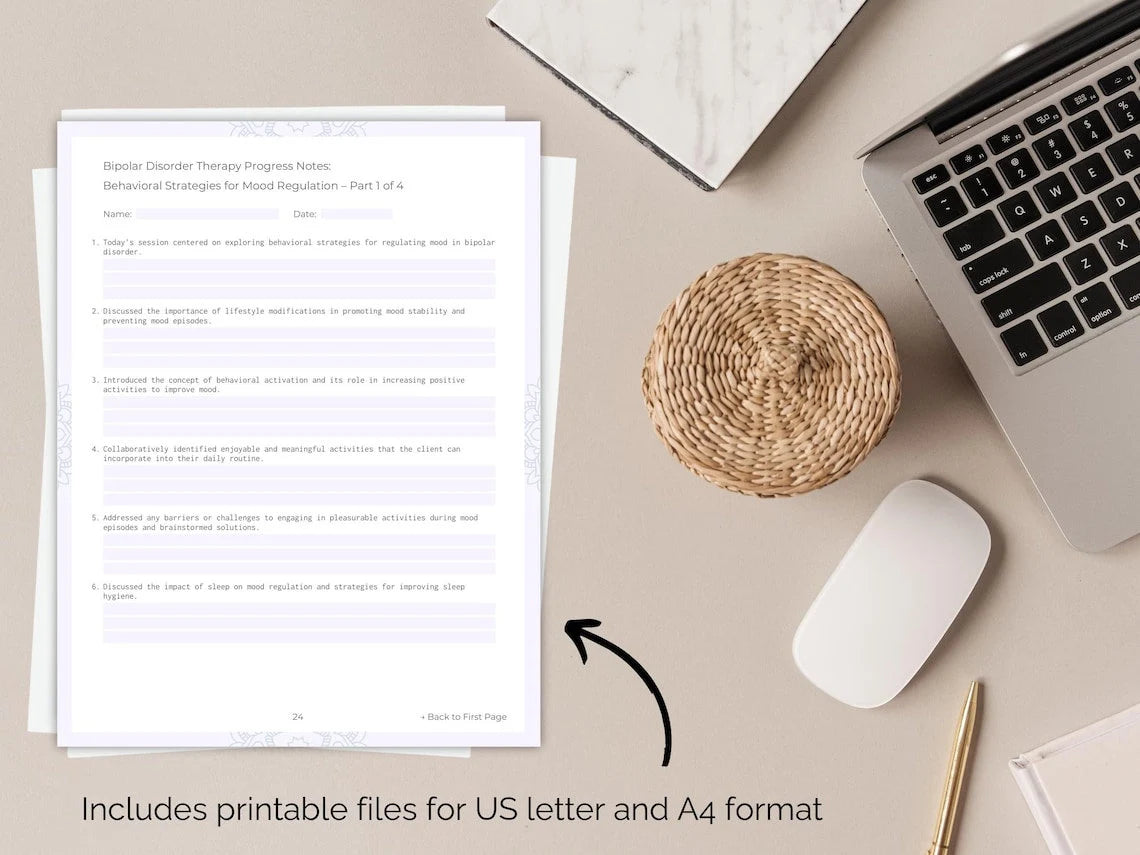Elevate Your Therapy and Guide Your Clients to Inner Healing with Our Adolescents Therapy Interventions! ✨
1. Starting Therapy
- Begin by establishing a warm and inviting atmosphere to help the adolescent feel comfortable and at ease.
- Invite the adolescent to share their reasons for seeking therapy and what they hope to accomplish through the process.
- Discuss confidentiality and its limits, emphasizing the importance of trust and privacy within the therapeutic relationship.
- Validate the adolescent's emotions and experiences, acknowledging the challenges they may be facing without judgment.
- Collaboratively set goals for therapy, ensuring they are specific, achievable, and meaningful to the adolescent.
- Introduce relaxation and mindfulness techniques to help the adolescent manage stress and anxiety.
- Assess the adolescent's social and familial support systems, identifying sources of strength and areas for growth.
- Validate any concerns or fears the adolescent may have about therapy, addressing them openly and compassionately.
- Foster a sense of agency and self-efficacy by involving the adolescent in decision-making and problem-solving.
- Teach the adolescent coping skills and strategies to manage difficult emotions and situations effectively.
- Validate the adolescent's unique identity and experiences, honoring their individuality and autonomy.
Need more? Find all 500+ Therapy Interventions for Adolescents Therapy in our Digital Workbook!
2. Adolescent Psychoeducation
- Start by explaining the concept of psychoeducation in simple terms, highlighting its purpose in helping adolescents understand their thoughts, emotions, and behaviors.
- Discuss the normal developmental changes that occur during adolescence, including physical, cognitive, and social-emotional aspects.
- Provide information about the signs and symptoms of various mental health disorders, emphasizing the importance of early recognition and intervention.
- Educate adolescents about the stigma surrounding mental illness and encourage open discussion about their feelings and experiences.
- Introduce the concept of self-care and emphasize its importance in maintaining mental and emotional health.
- Explore common cognitive distortions and negative thinking patterns that may contribute to emotional distress.
- Provide information about the impact of technology and social media on mental health, discussing healthy usage habits and boundaries.
- Explore the effects of substance use and abuse on adolescent brain development and mental health.
- Address myths and misconceptions about mental illness, providing accurate information to dispel stigma and promote understanding.
- Discuss the impact of trauma and adverse childhood experiences on mental health, validating any past struggles the adolescent may have faced.
- Explore the role of family dynamics and communication patterns in adolescent mental health, offering strategies for improving family relationships.
Need more? Find all 500+ Therapy Interventions for Adolescents Therapy in our Digital Workbook!
3. Mindfulness for Adolescents
- Begin with a brief explanation of what mindfulness is and why it's beneficial for adolescents.
- Teach adolescents the "5-4-3-2-1" grounding technique to help them connect with their immediate environment.
- Encourage adolescents to practice mindful eating by paying close attention to the taste, texture, and sensations of each bite of food.
- Explore the idea of "mindful walking" where adolescents pay attention to each step they take, the sensations in their feet, and their surroundings.
- Introduce the concept of "mindful noticing," encouraging adolescents to become aware of their thoughts and feelings without getting caught up in them.
- Introduce the "RAIN" mindfulness practice: Recognize, Accept, Investigate, Non-Identify, as a way to deal with difficult emotions.
- Explore the connection between mindfulness and gratitude, encouraging adolescents to keep a gratitude journal.
- Teach adolescents how to use mindfulness to manage stress and anxiety in difficult situations.
- Discuss the role of mindfulness in improving focus and concentration, especially during tasks such as studying or homework.
- Lead adolescents through a guided body awareness meditation, helping them develop a deeper connection with their physical sensations.
- Discuss the potential benefits of mindfulness for improving sleep quality and lead adolescents through a relaxation exercise before bedtime.
Need more? Find all 500+ Therapy Interventions for Adolescents Therapy in our Digital Workbook!
4. Dialectical Behavior Therapy (DBT)
- Begin by introducing adolescents to the core principles of Dialectical Behavior Therapy (DBT), emphasizing the balance between acceptance and change.
- Guide adolescents through mindfulness exercises, such as mindful breathing or body scans, to help them develop awareness of their thoughts and sensations.
- Teach adolescents the STOP skill (Stop, Take a step back, Observe, Proceed mindfully) as a way to pause and respond effectively to difficult situations.
- Introduce emotion regulation skills to help adolescents identify and manage their emotions in healthy ways, such as through relaxation techniques or self-soothing activities.
- Guide adolescents in creating a personalized distress tolerance plan, including coping strategies they can use when faced with crisis situations.
- Introduce the DEARMAN skill (Describe, Express, Assert, Reinforce, Mindful, Appear confident, Negotiate) to help adolescents communicate effectively and assertively in difficult situations.
- Teach adolescents interpersonal effectiveness skills, such as DEARMAN, GIVE (be Gentle, act Interested, Validate, use an Easy manner), and FAST (be Fair, no Apologies, Stick to values, be Truthful), to improve their relationships and communication.
- Explore the concept of dialectics with adolescents, helping them recognize and reconcile conflicting thoughts, feelings, and beliefs.
- Discuss the concept of wise mind with adolescents, encouraging them to find a balance between emotional and rational thinking.
- Guide adolescents in creating a self-soothe kit, filled with comforting items or activities they can turn to during times of distress.
- Teach adolescents opposite action skills, encouraging them to act opposite to their emotional impulses when those impulses are unhelpful or harmful.
Need more? Find all 500+ Therapy Interventions for Adolescents Therapy in our Digital Workbook!
5. Interpersonal Therapy for Adolescents (IPT)
- Begin by introducing adolescents to the core principles of Interpersonal Therapy for Adolescents (IPT), emphasizing its focus on improving interpersonal relationships and addressing interpersonal issues that contribute to emotional distress.
- Teach adolescents communication skills, such as active listening and assertiveness, to help them express their needs and boundaries effectively in their relationships.
- Introduce the concept of "interpersonal inventory" in IPT, where adolescents assess the quality and dynamics of their relationships, including strengths and areas for improvement.
- Discuss with adolescents the concept of "role transitions," such as moving to a new school or starting a new job, and help them navigate the challenges and adjustments associated with these transitions.
- Guide adolescents in exploring the impact of grief and loss on their interpersonal relationships, helping them process their emotions and adjust to changes in their lives.
- Explore with adolescents the concept of "interpersonal sensitivity," where they may feel overly sensitive to rejection or criticism in their relationships, and help them develop coping strategies for managing these feelings.
- Guide adolescents in identifying and challenging negative relationship patterns or dynamics that contribute to their distress.
- Explore with adolescents the concept of "social support," including the importance of seeking help and support from friends, family, and other trusted individuals.
- Guide adolescents in exploring the impact of cultural and societal factors on their interpersonal relationships, including cultural norms and expectations.
- Discuss with adolescents the concept of "emotional expression" in relationships, encouraging them to express their feelings openly and honestly with others.
- Teach adolescents assertiveness skills, including how to assert their needs and preferences while respecting the rights and boundaries of others.
Need more? Find all 500+ Therapy Interventions for Adolescents Therapy in our Digital Workbook!
6. Emotion-Focused Therapy (EFT)
- Begin by introducing adolescents to the core principles of Emotion-Focused Therapy (EFT), emphasizing the importance of exploring and processing emotions in therapy.
- Guide adolescents in identifying and labeling their emotions, helping them develop a vocabulary for expressing their feelings.
- Explore with adolescents the connection between their emotions and their thoughts, behaviors, and physical sensations, helping them understand the holistic nature of emotional experience.
- Guide adolescents in exploring the origins of their emotions, helping them identify underlying needs, desires, or past experiences that may be influencing their emotional responses.
- Explore with adolescents the concept of emotional processing, where they engage in reflective exercises or conversations to deepen their understanding of their emotions and their meanings.
- Guide adolescents in exploring their emotional patterns and triggers, helping them identify situations or events that tend to evoke strong emotional reactions.
- Explore with adolescents the concept of emotional avoidance, where they may engage in behaviors or distractions to avoid or suppress their emotions, and help them develop alternative coping strategies.
- Guide adolescents in exploring their emotional needs and desires, helping them identify what they need to feel emotionally fulfilled and satisfied.
- Explore with adolescents the concept of emotional regulation strategies, such as problem-solving or seeking social support, to help them effectively manage their emotions in various situations.
- Guide adolescents in exploring the role of attachment in their emotional experiences, helping them understand how their early attachment relationships may influence their current emotional patterns.
- Explore with adolescents the concept of emotional repair, where they engage in processes or activities that help restore emotional balance and resilience.
Need more? Find all 500+ Therapy Interventions for Adolescents Therapy in our Digital Workbook!
7. Psychodynamic Approaches for Teens
- Begin by establishing a supportive and empathetic therapeutic relationship with the adolescent, providing a safe space for them to explore their thoughts, feelings, and experiences.
- Explore the adolescent's early childhood experiences and attachments, examining how these may influence their current relationships and behaviors.
- Utilize free association techniques to help the adolescent express their thoughts and feelings without censorship or judgment, allowing for the exploration of unconscious material.
- Use interpretation to help the adolescent gain insight into the underlying meanings and motivations behind their thoughts, feelings, and behaviors.
- Encourage the adolescent to explore their feelings of ambivalence or conflict, helping them understand and resolve inner tensions.
- Explore the adolescent's identity development and sense of self, examining how they perceive themselves and how others perceive them.
- Use transference and countertransference dynamics to explore the adolescent's unconscious feelings and reactions towards the therapist, providing insights into their inner world.
- Explore the adolescent's creativity and imagination, using art, writing, or other expressive modalities to access and explore unconscious material.
- Encourage the adolescent to explore their hopes, fears, and aspirations for the future, helping them envision and work towards their goals.
- Use mindfulness and relaxation techniques to help the adolescent manage stress, anxiety, and other difficult emotions.
- Use guided imagery and visualization exercises to help the adolescent access and explore their inner resources and strengths.
Need more? Find all 500+ Therapy Interventions for Adolescents Therapy in our Digital Workbook!
8. Music Therapy for Teens
- Begin by introducing the adolescent to various types of music, including different genres, styles, and instruments, to explore their preferences and interests.
- Encourage the adolescent to create playlists of songs that resonate with their thoughts, feelings, and experiences, using music as a form of self-expression and reflection.
- Provide opportunities for the adolescent to engage in active music-making, such as singing, playing instruments, or songwriting, to express themselves creatively.
- Encourage the adolescent to create their own songs or compositions, using music as a way to communicate their thoughts, feelings, and experiences.
- Explore the adolescent's cultural and musical identity, discussing how their musical preferences and experiences are influenced by their background and upbringing.
- Encourage the adolescent to create soundscapes or musical collages that represent different aspects of their life, emotions, or experiences.
- Explore the adolescent's memories and associations with specific songs or pieces of music, discussing how these songs evoke emotions or memories from their past.
- Encourage the adolescent to explore different roles in music-making, such as performer, composer, or listener, to develop a sense of agency and empowerment.
- Provide opportunities for the adolescent to collaborate with peers or family members on musical projects, fostering teamwork and communication skills.
- Explore the adolescent's relationship with music and how it has evolved over time, discussing how their musical preferences and experiences have shaped their identity.
- Provide opportunities for the adolescent to engage in music-making activities outside of therapy sessions, encouraging them to integrate music into their daily life as a form of self-care and expression.
Need more? Find all 500+ Therapy Interventions for Adolescents Therapy in our Digital Workbook!
9. Concluding Therapy Sessions
- Reflect on the progress the adolescent has made throughout their therapy journey, acknowledging their strengths, achievements, and areas of growth.
- Provide validation and affirmation for the adolescent's efforts and willingness to engage in the therapeutic process, recognizing their courage and commitment to personal growth.
- Explore the strategies and coping skills that the adolescent has developed during therapy, discussing how they can continue to apply these tools in their everyday life.
- Provide an opportunity for the adolescent to express any remaining concerns or unresolved issues they may have, validating their feelings and offering support.
- Offer resources and referrals for continued support outside of therapy, such as support groups, hotlines, or other mental health services in their community.
- Validate any mixed emotions the adolescent may be experiencing about ending therapy, acknowledging that it's normal to feel both relief and sadness about completing this phase of their journey.
- Discuss the possibility of future sessions or check-ins if the adolescent feels they would benefit from continued support or guidance in the future.
- Offer encouragement and reassurance to the adolescent as they transition out of therapy, reminding them that they have the resilience and inner resources to navigate life's challenges.
- Discuss confidentiality and the limits of confidentiality now that therapy is ending, ensuring the adolescent understands their rights and responsibilities regarding privacy.
- Celebrate the adolescent's growth and progress, highlighting specific examples of their resilience, courage, and perseverance throughout their therapy journey.
- Provide closure by summarizing the key themes and takeaways from the adolescent's therapy experience, reinforcing the progress they have made and the skills they have developed.
Need more? Find all 500+ Therapy Interventions for Adolescents Therapy in our Digital Workbook!
10. Final Session Closure
- Begin the final session by acknowledging the significance of the adolescent's journey in therapy and expressing gratitude for the opportunity to work together.
- Discuss any remaining goals or areas of focus that the adolescent may wish to address in the final session, ensuring that they feel supported in their continued growth and development.
- Reflect on the therapeutic relationship and the bond that has been formed between the adolescent and therapist, acknowledging the trust, openness, and mutual respect that have characterized their work together.
- Explore any challenges or obstacles the adolescent may have faced during therapy, discussing how they have navigated these challenges and grown stronger as a result.
- Provide an opportunity for the adolescent to express any remaining thoughts, feelings, or questions they may have before ending therapy, ensuring that they feel heard and understood.
- Offer encouragement and reassurance to the adolescent as they prepare to leave therapy, reminding them of their strengths, resilience, and capacity for growth.
- Discuss the possibility of future check-ins or follow-up sessions if the adolescent feels they would benefit from additional support or guidance in the future.
- Offer a symbolic gesture or ritual to mark the end of therapy, such as lighting a candle, sharing a meaningful quote, or creating a piece of art together.
- Discuss confidentiality and the limits of confidentiality now that therapy is ending, ensuring that the adolescent understands their rights and responsibilities regarding privacy.
- Discuss the importance of maintaining boundaries and self-care practices as the adolescent moves forward, empowering them to prioritize their well-being and make healthy choices.
- Provide the adolescent with contact information and resources for additional support services or referrals in their community, ensuring that they have access to ongoing support if needed.
We hope that our therapy interventions for Adolescents therapy will help you to elevate your therapy practice and guide your clients to inner healing! Do you need more therapy interventions for Adolescents therapy? Find them all in our Digital Workbook! Or do you have any questions or suggestions for us? Please feel free to contact us at any time!

